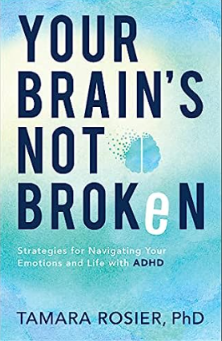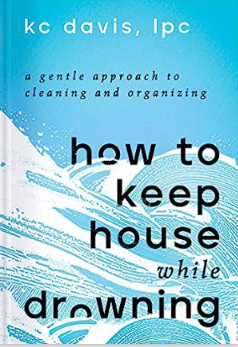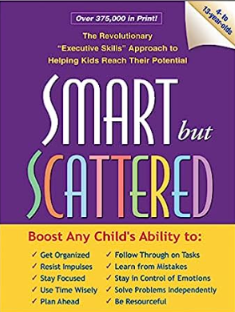As promised, here is a list of some of my favorite ADHD books, just in time for Prime Days on July 11 and 12. Here we go!
 Your Brain’s Not Broken – Tamara Rosier
Your Brain’s Not Broken – Tamara Rosier
If you are only going to buy one book from my recommendations, this would be the one I would say is a must. I have been fortunate enough to attend a few webinars held by Tamara Rosier, so I was excited to read her book-and it did not disappoint! Your Brain’s Not Broken has user-friendly explanations of ADHD brain differences, including examples. Additionally, the strategies presented, which take the emotional dysregulation ADHDers can experience fully into account, are explained so well that they can be put into action quickly and easily.
What I love about this book: I love everything about Your Brain’s Not Broken! First of all, the notion of motivation being determined by emotions is so thought provoking; it makes so much sense, but this is the first time I’m seeing it spelled out so clearly. Also, Rosier’s presentation of different clients, and her own ADHD, makes this book so relatable. I couldn’t put it down! https://amzn.to/3NF0YzH
ADHD 2.0 – Edward M. Hallowell and John J. Ratey 
Dr. Hallowell could be called one of the Grand Poobahs of ADHD research, treatment, and writing. ADHD 2.0 is an update to Hallowell’s original book, Driven to Distraction, which was (and still is) the ADHD bible. ADHD 2.0, in addition to explaining the brain science behind ADHD, also discusses different ways to enable ADHDers to thrive (such as exercise and connecting with others).
What I love about this book: Dr. Hallowell’s approach is strengths based, meaning that rather than focus on what one has difficulty with, ADHDers are encouraged to lean on what they are great at. Dr. Hallowell is such a positive force in ADHD treatment, and that shines through in ADHD 2.0. https://amzn.to/44EculN
 how to keep house while drowning – KC Davis
how to keep house while drowning – KC Davis
This book, and the YouTube and TikTok videos that KC Davis has created, are legendary among ADHDers. Ms. Davis has developed Struggle Care, a very basic plan for keeping your house in some form of order, based on the (very true) concept that having a messy house is not a moral failure, it is simply a functional challenge. how to keep house while drowning has suggestions for housekeeping that take into account ADHD, depression, anxiety, postpartum…basically, life. You can use the 31 day plan that is presented, or just read through and choose what you’d like to work on.
What I love about this book: Throughout how to keep house while drowning, one feels like you are sitting and schmoozing with a friend who is telling you that it’s all going to be okay, and that you’re being too hard on yourself. It’s a comforting little booklet. https://amzn.to/46EJfAY
Smart But Scattered – Peg Dawson and Richard Guare 
Smart But Scattered is a great book for parents who are looking for practical advice on how to help their ADHD child work with their challenged executive functions. There is a terrific explanation of what the executive functions are, with examples. A section on general strategies to employ when dealing with your child follows. Finally, there are suggestions (with implementation plans) and examples relating to a variety of issues that any ADHD parent will recognize.
What I love about this book: The approach that is presented in Smart But Scattered towards working with your ADHD child is on point. Dawson and Guare tell parents to “modify tasks to match your child’s capacity to exert effort,” and “begin by changing things outside the child before…strategies that require the child to change.” In other words, work with your child, not against them. Doesn’t sound terribly profound…but it is. https://amzn.to/3O4zUuR
 All Dogs Have ADHD – Kathy Hoopmann
All Dogs Have ADHD – Kathy Hoopmann
All Dogs Have ADHD is a picture book full of dogs doing, well, dog things. But what makes this book special is that the pictures tell the story of ADHD. So, a dog jumping into a lake is “diving straight into a situation without thinking about the consequences.” You get the idea. This book is great for kids who have ADHD, and also those who don’t, but spend time around ADHDers. The photographs are beautiful, and the pups are adorable.
What I love about this book: Parents often want to sugarcoat for their kids. All Dogs Have ADHD doesn’t do that-while the book does end on a very positive note, the positives and negatives are given equal time. Also…dogs. Need I say more?? (PS-there is a companion book, All Cats Are On The Autism Spectrum) https://amzn.to/46RhntE
I could go on and on..but I’ll save some of my faves for another post down the road. Happy Reading!!
Disclosure: I am an Amazon associate, and have an affiliate relationship with Amazon.
